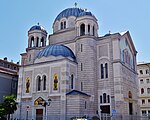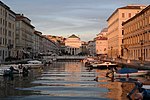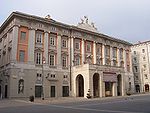Sant'Antonio Taumaturgo, Trieste
19th-century Roman Catholic church buildings in ItalyBuildings and structures completed in 1842Buildings and structures in TriesteChurches completed in 1842Churches in the province of Trieste

The Church of Sant'Antonio Taumaturgo (commonly known as the Church of Sant'Antonio Nuovo), is the main religious building in the Borgo Teresiano in the centre of Trieste as well as the city's largest Catholic church. It stands on a square also known as Sant’Antonio Nuovo, at the end of the Grand Canal.The building project dates back to 1808, but work only began in 1825. The church has a facade of ionic columns with six statues sculpted by Francesco Bosa in 1842, representing Saint Justus, Saints Sergius and Bacchus, Saint Servulus, Saint Maurus, Saint Euphemia and Saint Tecla.
Excerpt from the Wikipedia article Sant'Antonio Taumaturgo, Trieste (License: CC BY-SA 3.0, Authors, Images).Sant'Antonio Taumaturgo, Trieste
Via San Lazzaro, Trieste San Giusto
Geographical coordinates (GPS) Address External links Nearby Places Show on map
Geographical coordinates (GPS)
| Latitude | Longitude |
|---|---|
| N 45.6514 ° | E 13.7751 ° |
Address
Chiesa di Sant'Antonio Taumaturgo
Via San Lazzaro
34122 Trieste, San Giusto
Friuli-Venezia Giulia, Italy
Open on Google Maps









